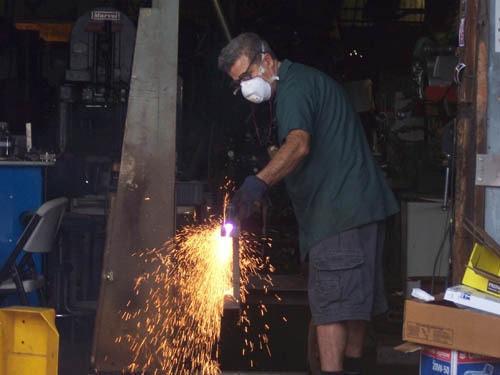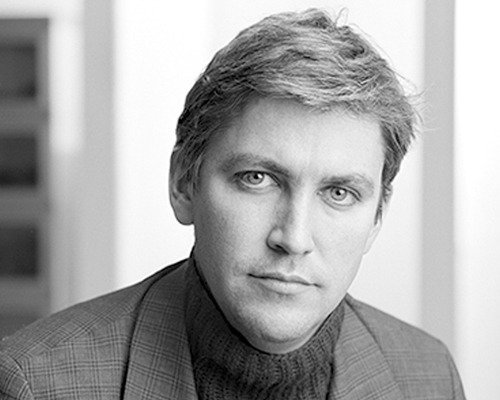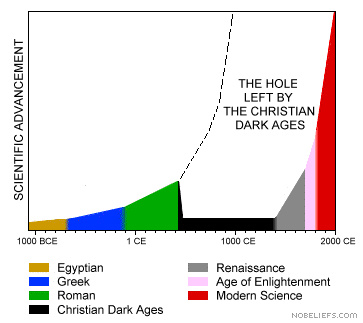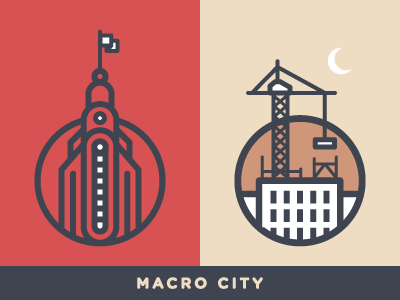Stewart Brand's Blog, page 55
May 2, 2014
Manual for Civilization Book List from Mark Pauline of Survival Research Labs
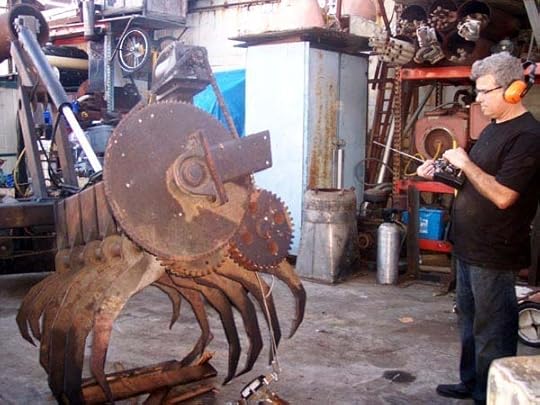
Photo of Mark Pauline by Karen Marcelo
What information is essential to sustaining civilization? What books would you want to have if we had to start from scratch? What references would we need available to rebuild what we have today? Long Now is collecting 3,500 books based on those questions to form a Manual for Civilization. We’ve asked for suggestions from Long Now members, donors to The Interval at Long Now (where this library will be housed), and a diverse, distinguished group of experts who we’ve invited to help.
Today’s list of additions to the Manual for Civilization comes from a groundbreaking artist whose work suggests a post-apocalyptic future full of fiery marauding mechanical creatures. For 35+ years Mark Pauline has been building and destroying machines as founder and leader of Survival Research Laboratories (SRL).
Two decades before Robot Wars and BattleBots made DIY-built robo-gladiators a television spectacle, Mark Pauline and SRL were creating their own machines out of industrial detritus and staging underground events in San Francisco that were full of flying metal, shooting fire and lots and lots of noise.
Since 01978, SRL has produced more than 50 events around the world with a mission to “[re-direct] the techniques, tools, and tenets of industry, science, and the military away from their typical manifestations in practicality, product or warfare”. Here’s what that looks like:

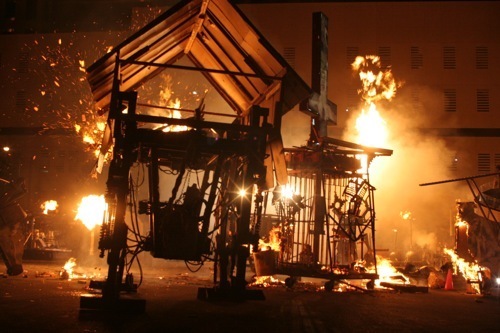
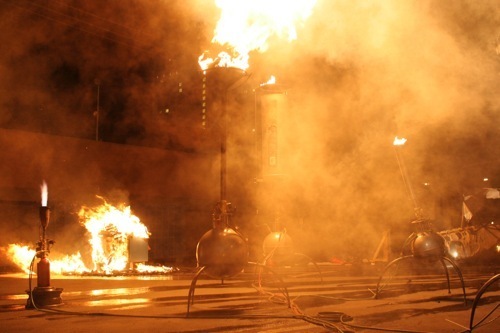
SRL show photos by Jacob Appelbaum
Mark’s book list includes the nearly 3,000-page Machinery’s Handbook plus fiction by Ballard, Burroughs and Pynchon amongst others. His one historical entry, unsurprisingly, is a social history of technology and warfare: War in the Age of Intelligent Machines.
Here’s Mark Pauline’s complete selections for the Manual for Civilization:
A Confederacy of Dunces by John Kennedy Toole
The Third Policeman by Flann O’Brien
The Uses of Disorder: Personal Identity & City Life by Richard Sennett
Extraordinary Popular Delusions and The Madness of Crowds by Charles MacKay
Crash by JG Ballard
Concrete Island by JG Ballard
The Wild Boys by William Burroughs
The Ticket that Exploded by William Burroughs
Erik Dorn by Ben Hecht
The Kingdom of Evil: A Continuation of the Journal of Fantazius Mallare by Ben Hecht
Ice by Anna Kavan
Maldoror (Les Chants de Maldoror) by Comte de Lautreamont
The Crying of Lot 49 by Thomas Pynchon
Against Nature by Joris-Karl Huysmans
The Damned (La-Bas) by Joris-Karl Huysmans
Impressions of Africa by Raymond Roussel
Locus Solus by Raymond Roussel
Hyperion by Dan Simmons
Neuromancer by William Gibson
Venus in Furs by Leopold von Sacher- Masoch
Machinery’s Handbook by Erik Oberg and Franklin D. Jones
War in the Age of Intelligent Machines by Manuel De Landa
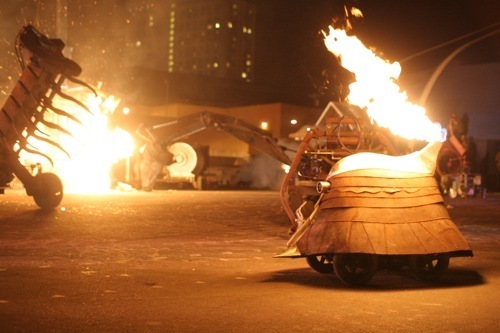
SRL show photos by Jacob Appelbaum
Thanks so much to Mark for taking the time to give us this great list. If the robo-uprising happens, now we’ll be ready.
Previously we’ve shared book lists from Neal Stephenson, Kevin Kelly, Maria Popova, and Brian Eno amongst others, and more suggestions are coming in from Long Now members and Interval donors. We are starting to acquire physical books for the shelves and are working with the Internet Archive to make digital versions of all these books available online. So whether you are visiting us at The Interval in San Francisco or on the other side of the world you can access the Manual for Civilization collection.
To add your recommendations for the Manual for Civilization and vote for which suggested titles should find a place on The Interval’s shelves, just make a donation to support the project. All donors, at any level, can suggest and vote on books. And your support will help give long-term thinkers an inspiring place to gather, full of amazing books.
This week The Interval “brickstarter” surpassed $400K in funding. That’s more than 80% of our fundraising goal. This covers the capital improvements and redesign of our space at Fort Mason Center in San Francisco, including the build out of a beautiful bar/cafe/event space for the public, offices for Long Now staff, and a world class audio-visual system for showcasing sound and visuals by Brian Eno.
We have a few weeks left to reach our final goal before we open our doors in May. Charter donors will get invites to pre-opening parties and lots of other great benefits. Very soon we’ll share details about our opening dates and the first events we’ll host at The Interval.

April 28, 2014
Sylvia Earle & Tierney Thys Seminar Tickets
The Long Now Foundation’s monthly
Seminars About Long-term Thinking

Sylvia Earle & Tierney Thys present “Oceanic”
TICKETS
Tuesday May 20, 02014 at 7:30pm SFJAZZ Center
Long Now Members can reserve 2 seats, join today! General Tickets $15
About this Seminar:
Land animals on an ocean planet, we have a lot to learn about how the world works. The microbes of the sea are Earth’s dominant life form. Ocean currents and temperatures drive climate and weather. Come ride a current to view bad news (dead zones, rising sea levels, melting sea ice, acidification, coral bleaching, fish piracy and overfishing) and good news (marine protected areas, functional ecosystems, megafaunal migrations, mid-Atlantic ridge, community involvement, citizen scientists) and continuing mysteries. Land is mercurial. Ocean abides.
Two of the most eloquent voices of ocean science are Sylvia Earle and Tierney Thys. Both are National Geographic Explorers, both are stars of the TED stage. They have collaborated on original and adventurous research. For this talk they are collaborating to tell (and show) sea stories of deep waters, the deep past, and the deep future.

Tony Hsieh Seminar Media
 This lecture was presented as part of The Long Now Foundation’s monthly Seminars About Long-term Thinking.
This lecture was presented as part of The Long Now Foundation’s monthly Seminars About Long-term Thinking.
Helping Revitalize a City
Tuesday April 22, 02014 – San Francisco
Audio is up on the Hsieh Seminar page, or you can subscribe to our podcast.
*********************
The downtown company – a summary by Stewart Brand
The business advice that Tony Hsieh most took to heart came from an ad executive: “A great brand is a story that never stops unfolding.” With his own company, Zappos, he determined that “brand equals culture,” and made quality of culture the top corporate priority, followed by customer service, and then selling shoes and clothing. The formula worked so well that Zappos outgrew its collection of buildings in suburban Las Vegas. Time to build a campus.
Other suburban corporate campuses—Google, Nike, Apple—struck him as isolated and insular. He wondered if a company could be like New York University, embedded in downtown Manhattan, with all of its buildings and no end of urban amenities within a five-minute walk. Edward Glaeser’s book The Triumph of the City described how cities unfold forever, driven by density and intense variety, while companies all eventually go stagnant and die. Maybe immersion in a downtown could help keep his company unfolding, and maybe bringing company start-up culture to a decaying urban core could restart its vitality.
Zappos bet the company on the idea. They took over the abandoned city hall in the dead-end part of Las Vegas known as Fremont East and spent $200 million buying up nearby properties, $50 million on local small businesses, $50 million on tech start-ups, and $50 million on education, arts, and culture. Hsieh’s strategy is to increase: “Collisions” (serendipitous encounters); “Co-learning” (a community teaching itself); and “Connectedness” (density, diversity, and reasons to engage).
They built a Shipping Container Park with three stories of shops, amusements, and tech start-ups wrapped around a courtyard for food, play, and hanging out. They planted Burning Man mega-art on corners throughout the neighborhood “to keep you walking one more block.” Inspired by TED, the Summit Series, and especially SXSW (the South by Southwest festival in Austin), they built a theater for frequent talks and organized an annual “Life is Beautiful” music festival attracting 60,000.
Hsieh figures that “collisionability” can be quantified and designed for. He thinks that street-level interaction can be made so rich that it compensates for the lower density of low-rise buildings, with 100 residents/acre. Thus he blocked off the skyway from Zappos’s parking lot to its headquarters in the city hall. Use the street. Make street activities really attractive. Active residents, he calculates, will experience 1,000 collisionable hours a year (3.6 hours/day, 7 days/week, 40 weeks/year). Ditto for “purposeful visitors” (12 hours/day, 7 days/week, 12 weeks/year)—you are invited to be one.
If Zappos helps foster an urban “culture of openness, collaboration, creativity, and optimism,” Hsieh says, then the city can prosper, and the company with it, and both can keep unfolding their stories indefinitely.
Subscribe to our Seminar email list for updates and summaries.

April 24, 2014
Long Short: Burning Man Timelapse
Before each of our SALT talks, we show what we call a “Long Short”, a short film that exemplifies long-term thinking. We pick films that are thematically related to the Seminar of the evening, yet don’t have too much overlap with the main content. For Tuesday’s Seminar, we hosted Tony Hsieh, CEO of Zappos and instigator of the Downtown Project, a $350 million dollar project to revitalize downtown Las Vegas.
For our Long Short, we showed a video by Jason Phipps, a videographer based out of Auburn, California. Here are his own words on how the film was created:
This video captures Burning Man 2013 from an elevation of 5495 feet above sea level and over 4 linear miles from the center of Black Rock City. Old Razorback, aka Trego Peak, provides a unique vista of this incredible annual event. Climbing to the peak of Old Razorback has become a challenging and rewarding tradition for our team. This is a view that most will never experience in person. It is our passion to share it with the world through the lens of a camera. Climbing 1,888 feet in less than a mile over steep, unstable mountainside is a dangerous and exhilarating mission. This year we deployed cameras during the build week, capturing the growth of the city and ending it the night of the burn. We express gratitude to the family and friends that joined us for this epic climb. We could not do it alone. Many thanks to our team this year: Mark Phipps, John Phipps, Dallon Phipps, Kevin Johnson & Meghan Johnson. We also offer heartfelt thanks to OpenOptics (Inspired Flight) and Dusty Nix for designing such an incredible sound score for this year’s rendition.
To learn more about Jason and his work, you can email him at jason_m_phipps@hotmail.com.

Tony Hsieh Long Short: Burning Man Timelapse
Before each of our SALT talks, we show what we call a “Long Short”, a short film that exemplifies long-term thinking. We pick films that are thematically related to the Seminar of the evening, yet don’t have too much overlap with the main content. For Tuesday’s Seminar, we hosted Tony Hsieh, CEO of Zappos and instigator of the Downtown Project, a $350 million dollar project to revitalize downtown Las Vegas.
For our Long Short, we showed a video by Jason Phipps, a videographer based out of Auburn, California. Here are his own words on how the film was created:
This video captures Burning Man 2013 from an elevation of 5495 feet above sea level and over 4 linear miles from the center of Black Rock City. Old Razorback, aka Trego Peak, provides a unique vista of this incredible annual event. Climbing to the peak of Old Razorback has become a challenging and rewarding tradition for our team. This is a view that most will never experience in person. It is our passion to share it with the world through the lens of a camera. Climbing 1,888 feet in less than a mile over steep, unstable mountainside is a dangerous and exhilarating mission. This year we deployed cameras during the build week, capturing the growth of the city and ending it the night of the burn. We express gratitude to the family and friends that joined us for this epic climb. We could not do it alone. Many thanks to our team this year: Mark Phipps, John Phipps, Dallon Phipps, Kevin Johnson & Meghan Johnson. We also offer heartfelt thanks to OpenOptics (Inspired Flight) and Dusty Nix for designing such an incredible sound score for this year’s rendition.
To learn more about Jason and his work, you can email him at jason_m_phipps@hotmail.com.

April 22, 2014
Steven Johnson: The Long Zoom – A Seminar Flashback
In May 02007 author Steven Johnson spoke for Long Now about The Long Zoom, which is his take on how humans integrate perspectives at different scales for both pleasure and practical reasons. He explains this “zoom” in everything from computer games to ending the cholera epidemic in 19th century London. That last topic, the subject of his book The Ghost Map, serves as a leaping off point for this Seminar.
Twice a month we highlight a Seminar About Long-term Thinking (SALT) from our archives. Long Now members can watch this video here. The audio is free for everyone on the Seminar page and via podcast. Long Now members can see all Seminar videos in HD. Video of the 12 most recent Seminars is also free for all to view.
In his introduction Stewart Brand calls Johnson a polymath, and this talk is a truly polymathic display across disciplines, history, and literature. But it’s also easy to follow because much of it takes place in the realm of current pop culture: from the TV show Lost to the games SimCity and Spore. Even Johnson’s revisiting of London’s 01800′s brings with it insights into the history of infographics.
The talk itself is a zoom and Johnson shows implicitly that integrating perspectives is useful, and pleasurable, to the way human minds work today. New research on gaming and the brain, the history of detective fiction, and the UI of World of Warcraft are all side trips on Johnson’s guided tour to how the Long Zoom, both as a practical tool and an entertainment principle, can lead to consilience.
From Stewart’s summary of this Seminar (in full here):
Johnson proposed that another word for the long zoom perspective is “consilience”— a fine old word, revived by Edward O. Wilson, that links multiple disciplines and multiple levels into a whole body of knowledge with extra benefits the separate disciplines lack. Science and culture can blend rigorously. What is discovered in consilience is not just scales of distance or time but nested systems.
Steven Johnson is the author of eight books which cover topics in science, technology, history and popular culture including Emergence, Everything Bad Is Good for You and most recently Future Perfect.
The Seminars About Long-term Thinking series began in 02003 and is presented each month live in San Francisco. The series is curated and hosted by Long Now’s President Stewart Brand. Seminar audio is available to all via podcast.
Long Now members can watch the full video of this Seminar here—you must be logged in to the site. Membership levels start at $8/month and include lots of benefits. Join Long Now today.

April 19, 2014
The Knowledge
One of the early inspirations for creating the Manual for Civilization was an email I received from Lewis Dartnell in London asking me for information on a book he was writing inspired by James Lovelock’s “Book for all Seasons”. The idea was a kind of reboot manual for humanity, and it coincided well with some other conversations we had been having at Long Now about making a collection of books that could do something similar.
Fast forward to 02014 and Lewis has finished his book “The Knowledge: How to Rebuild Our World From Scratch” which comes out today, and he was kind enough to send us a copy for our Manual for Civilization library collection. Since this is a single volume you might be wondering how much practical knowledge a book like this could actually impart. This book gives the reader a basic strategy for rebooting civilization – not every detail. For instance if you wanted to get a certain technology up and running again, which method should you employ given what we now know about modern and historical methods? Dartnell goes over the basic principle for each fundamental technology, and then discusses best options for how to rebuild it with scavenged materials (always easier), or how you might do it from scratch. He starts with the most critical and fundamental, and then builds on each of these as the book progresses. So in a way the book kind of boot straps itself from chapter to chapter. The overall goal, it seems, is to make the “hole” referred to in the graph below smaller and recover faster than the one left after the fall of Rome. (yes I know there are lots of issues with that graph but it illustrates the point of a loss of technology in civilizations)
The Knowledge is not another survival guide for gun toting doomsday “preppers”, or those excited for the zombie apocalypse, but both crowds might get something out of it. It is also not a standalone book, Lewis has published his chapter by chapter further reading list and bibliography alongside it that contains the nitty gritty details for each of the technologies discussed. You should consider The Knowledge a primer and table of contents for that larger reading list. We are happy to have The Knowledge in our collection for this reason.
Dartnell has also been following The Manual for Civilization project and has submitted his own list of books for our collection, which we include below. He considers these to be the most useful from his bibliography.
Self-sufficiency & providing the essentials
Seymour, John, The New Complete Book of Self-sufficiency, Dorling Kindersley, 2009.
Strawbridge, Dick and James Strawbridge, Practical Self Sufficiency: The Complete Guide to Sustainable Living, Dorling Kindersley, 2010.
Leckie, Jim, Gil Masters, Harry Whitehouse and Lily Young, More Other Homes and Garbage: Designs for Self-sufficient Living (ATL 02–47), Sierra Club Books, 1981.
Stoner, Carol Hupping, Stocking Up: How to Preserve the Foods you Grow, Naturally (ATL 07–292), Rodale Press, 1973.
Boyle, Godfrey and Peter Harper, Radical Technology: Food, Shelter, Tools, Materials, Energy, Communication, Autonomy, Community (ATL 01–13), Undercurrent Books, 1976.
Scavenging and repurposing
Vogler, Jon, Work from Waste: Recycling Wastes to Create Employment (ATL 33–804), ITDG Publishing, 1981.
Tools & construction
Gingery, David J., The Charcoal Foundry, David J. Gingery Publishing LLC, 2000a.
The Drill Press, David J. Gingery Publishing LLC, 2000b.
The Metal Lathe, David J. Gingery Publishing LLC, 2000c.
The Metal Shaper, David J. Gingery Publishing LLC, 2000d.
The Milling Machine, David J. Gingery Publishing LLC, 2000e.
Johnson, Carl G. and William R. Weeks, Metallurgy (ATL 04–106), 5th edn, American Technical Publishers, 1977.
Jackson, Albert and David Day, Tools and How to Use Them: An Illustrated Encyclopedia (ATL 04–122), Alfred A. Knopf, 1978.
Gentry, George and Edgar T. Westbury, Hardening and Tempering Engineers’ Tools (ATL 04–98), Model and Allied Publications, 1980.
Forest Service Forest Products Laboratory, Wood Handbook: Wood as an Engineering Material (ATL 25–662), US Department of Agriculture, 1974.
Lengen, Johan van, The Barefoot Architect: A Handbook for Green Building, Shelter, 2008.
Fuel
Stanford, Geoffrey, Short Rotation Forestry: As a Solar Energy Transducer and Storage System (ATL 08–301), Greenhills Foundation, 1976.
House, David, The Biogas Handbook (ATL 24–568), Peace Press, 1978. Revised edition published by House Press in 2006.
Stassen, Hubert E., Small-Scale Biomass Gasifiers for Heat and Power: A Global Review, Energy Series, World Bank Technical Paper Number 296, 1995.
LaFontaine, H. and F. P. Zimmerman, Construction of a Simplified Wood Gas Generator for Fueling Internal Combustion Engines in a Petroleum Emergency, Federal Emergency Management Agency, 1989.
Hygiene and Medicine
Huisman, L. and W. E. Wood, Slow Sand Filtration (ATL 16–376), World Health Organisation, 1974.
Conant, Jeff, Sanitation and Cleanliness for a Healthy Environment, Hesperian Foundation, 2005.
Mann, Henry Thomas and David Williamson, Water Treatment and Sanitation: Simple Methods for Rural Areas (ATL 16–381) (revised edition), Intermediate Technology Publications, 1982.
Gotaas, Harold B., Composting: Sanitary Disposal and Reclamation of Organic Wastes (ATL 05–166), World Health Organization, 1976. First published 1956.
Werner, David, Where There Is No Doctor: A Village Healthcare Handbook, Hesperian Health Guides, 2011.
Cook, John, Balu Sankaran and Ambrose E. O. Wasunna (eds), General Surgery at the District Hospital (ATL 27–721), World Health Organization, 1988.
Dobson, Michael B., Anaesthesia at the District Hospital (ATL 27–720), World Health Organisation, 1988.
Porter, Roy, Blood and Guts: A Short History of Medicine, Penguin, 2002.
Power and mechanisms
Brown, Henry T., 507 Mechanical Movements: Mechanisms and Devices, 18th edn, BN Publishing, 2008. First published 1868.
Hiscox, Gardner Dexter, 1800 Mechanical Movements, Devices and Appliances, Dover Publications, 2007.
Bureau of Naval Personnel, Basic Machines and How They Work (ATL 04–81), Dover Publications, 1971.
Hillier, V. A. W. and F. Pittuck, Fundamentals of Motor Vehicle Technology, 3rd edn, Hutchinson, 1981.
Substances and chemistry
William B. Dick, Dick’s Encyclopedia of Practical Receipts and Processes
Alan P. Dalton, Chemicals from Biological Resources
Dunn, Kevin M., Caveman Chemistry: 28 Projects, from the Creation of Fire to the Production of Plastics, Universal Publishers, 2003.
Dumesny, P. and J. Noyer, Wood Products: Distillates and Extracts, Scott Greenwood & Son, 1908.
Wingate, Michael, Small-scale Lime-burning: A practical introduction (ATL 25–675), Practical Action, 1985.
Abdel-Aal, H. K., K. M. Zohdy and M. Abdel Kareem, ‘Hydrogen Production Using Sea Water Electrolysis’, The Open Fuel Cells Journal, 3:1–7, 2010.
Science and technological progress
Patricia Fara, Science: A Four Thousand Year History
Shapin, Steven, The Scientific Revolution, The University of Chicago Press, 1996.
Thomas Crump, A Brief History of Science: As seen throughout the development of scientific instruments
Hasok Chang, Inventing Temperature: Measurement and Scientific Progress, Oxford University Press, 2004.
Macfarlane, Alan and Gerry Martin, The Glass Bathyscaphe: How Glass Changed the World, Profile Books, 2002.
Abbott Payson Usher, A History of Mechanical Inventions
George Basalla, The Evolution of Technology
Mokyr, Joel, The Lever of Riches: Technological Creativity and Economic Progress, Oxford University Press, 1990.

April 17, 2014
Neal Stephenson’s Selected Books for the Manual for Civilization

Best-selling author Neal Stephenson has added a couple dozen books to the Manual for Civilization. Long Now is assembling a corpus of 3,500 volumes that would help sustain or rebuild civilization. This collection will be featured at The Interval, our new public space, as a floor-to-ceiling library available to our visitors. The collection will comprise books suggested by Long Now members and charter donors to the Interval project. We’ve also invited a select group of eminent friends of Long Now, including archivists, artists, authors, educators, scientists and more, to submit lists of the books they believe are essential to Civilization.
Neal Stephenson is an author of speculative fiction whose ground-breaking novels include Snow Crash, Cryptonomicon, and Anathem, a book based in a world of 10,000 Year Clocks inspired by our own Clock of the Long Now. In fact, Neal is both a Long Now member and a charter donor to The Interval. You can join him by making a tax-deductible gift before we open in May. Every donation helps now when we need it most, and we have some wonderful ways to thank you at every level.
For thirty years Neal Stephenson’s writing has been distinguished by how he weaves minutely detailed historical and technical information into his complex stories, usually with a wicked sense of humor. Whether its fashion in Victorian England or World War II era cryptography, his dedication to detailed research is readily apparent. The Baroque Cycle novels perhaps most exemplify this, as they focus on key people and events in the development of science across many cultures in the 17th and 18th centuries. We knew his recommendations would be invaluable for this project.
Many of the research sources for his novels can be found in his home library. And it was an honor and privilege that Neal walked me through his library and thoughtfully selected the list of books below for the Manual for Civilization. You can see from his selections that he believes understanding history is essential to creating the best possible future.
Decline and Fall of the Roman Empire, Volumes 1-6 by Edward Gibbon
The Odyssey by Homer translated by Robert Fagles
The Iliad by Homer translated by Robert Fagles
The: Civilization & Capitalism 15th-18th Century, Volumes 1-3 by Fernand Braudel
1491: New Revelations of the Americas Before Columbus by Charles C. Mann
Newton’s Principia for the Common Reader by S. Chandrasekhar
Leviathan: Or the Matter, Forme, and Power of a Commonwealth Ecclesiasticall and Civil by Thomas Hobbes
The American Practical Navigator: An Epitome of Navigation by Nathaniel Bowditch
Pax Britannica: A Three Volume Set (Heaven’s Command, Pax Britannica, and Farewell the Trumpets) by James Morris
Son Of The Morning Star: Custer and the Little Bighorn by Evan S. Connell
The Siege at Peking by Peter Fleming
Marlborough, His Life & Times, Volumes 1-6 by Winston Churchill
The Making of the Atomic Bomb by Richard Rhodes
Dark Sun: The Making of the Hydrogen Bomb by Richard Rhodes
The Road to Reality: A Complete Guide to the Laws of the Universe by Roger Penrose
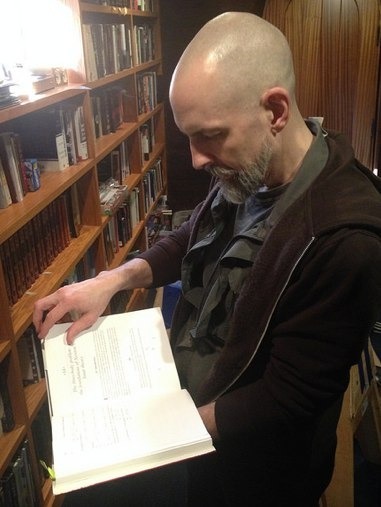
Many thanks to Neal Stephenson for taking the time and care to recommend these books for our collection. His list adds to suggestions from Kevin Kelly, Maria Popova, Violet Blue, Stewart Brand, Brian Eno and dozens of other Long Now members and supporters.
Starting in late May you can visit the Manual yourself at The Interval Long Now’s new public venue in San Francisco’s Fort Mason Center. The Interval will also feature Long Now artifacts and prototypes, sound and light art installations by Brian Eno, a cocktail menu designed on the theme of time, fine coffee and tea, and small scale events on long-term thinking and related topics.
Check back for lists from Danny Hillis and Neil Gaiman, amongst others. And for details on The Interval’s May 02014 public opening, as well as pre-opening events for charter donors. Your gifts help us pay for construction, acquire the books for the Manual for Civilization, build the A/V system to present Brian Eno’s art, and everything else that will make The Interval a one-of-a-kind venue worthy of Long Now’s mission to inspire and extol long-term thinking. Thanks for considering a gift.

April 16, 2014
Mariana Mazzucato Seminar Media
 This lecture was presented as part of The Long Now Foundation’s monthly Seminars About Long-term Thinking.
This lecture was presented as part of The Long Now Foundation’s monthly Seminars About Long-term Thinking.
The Entrepreneurial State: Debunking Private vs. Public Sector Myths
Monday March 24, 02014 – San Francisco
Video is up on the Mazzucato Seminar page for Members.
*********************
Audio is up on the Mazzucato Seminar page, or you can subscribe to our podcast.
*********************
Government as radical, patient VC – a summary by Stewart Brand
The iPhone, Mazzucato pointed out, is held up as a classic example of world-changing innovation coming from business.
Yet every feature of the iPhone was created, originally, by multi-decade government-funded research. From DARPA came the microchip, the Internet, the micro hard drive, the DRAM cache, and Siri. From the Department of Defense came GPS, cellular technology, signal compression, and parts of the liquid crystal display and multi-touch screen (joining funding from the CIA, the National Science Foundation, and the Department of Energy, which, by the way, developed the lithium-ion battery.) CERN in Europe created the Web. Steve Jobs’ contribution was to integrate all of them beautifully.
Venture Capitalists (VCs) in business expect a return in 3 to 5 years, and they count on no more than one in ten companies to succeed. The time frame for government research and investment embraces a whole innovation cycle of 15 to 20 years, supporting the full chain from basic research through to viable companies. That means they can develop entire new fields such as space technology, aviation technology, nanotechnology, and, hopefully, Green technology.
But compare the reward structure. Government takes the greater risk with no prospect of great reward, while VCs and businesses take less risk and can reap enormous rewards. “We socialize the risks and privatize the rewards.” Mazzucato proposes mechanisms for the eventual rewards of deep innovation to cycle back into a government “innovation fund”—perhaps by owning equity in the advantaged companies, or retaining a controlling “golden share” of intellectual property rights, or through income-contingent loans (such as are made to students). “After Google made billions in profits, shouldn’t a small percentage have gone back to fund the public agency (National Science Foundation) that funded its algorithm?” In Brazil, China, and Germany, state development banks get direct returns from their investments.
The standard narrative about government in the US is that it stifles innovation, whereas the truth is that it enables innovation at a depth that business cannot reach, and the entire society, including business, gains as a result. “We have to change the way we think about the state,” Mazzucato concludes.
Subscribe to our Seminar email list for updates and summaries.

April 15, 2014
Explore Urban Infrastructure at the MacroCity Conference, May 30-31
We rarely see in full the cities that we live in. Focused on our daily lives, urban dwellers are often only dimly aware of the numerous, enmeshed layers of critical infrastructure that quietly hum in the background to make modern life possible.
Come and explore the amazing stories and surprising histories to be found lurking just below the surface of our cities at MacroCity, a two-day, whirlwind tour of this bigger picture of urban life. The event brings together a diverse set of panelists, speakers, and participants to explore the vast, often overlooked networks of infrastructure that surround us. The line-up includes rogue archivist and Lost Landscapes creator Rick Prelinger, as well as Laci Videmsky of the New California Water Atlas.
The schedule also includes a variety of field trips, offering an opportunity to explore first-hand some of the vast networks of infrastructure that sustain the Bay Area.
Organized by the Bay Area Infrastructure Observatory, the conference will take place on May 30-31 at SPUR and the Brava Theater in San Francisco. The Long Now Foundation is partnering with BAIO on the event, and Long Now members receive a 25% discount on tickets – please check your email for your discount code.
Field trips will take place on May 30th, with most of the speakers scheduled for May 31st. A basic pass to the talks can be reserved for $100; the deluxe pass for $150 includes access to a field trip, as well. Half-price tickets are available for members of the nonprofit community; please see the event registration page for more information.

Stewart Brand's Blog
- Stewart Brand's profile
- 291 followers


